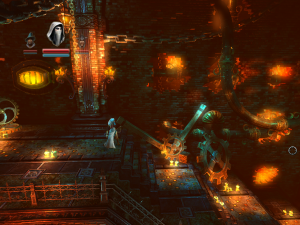Trine
 The main thing I have to say about Trine is that it’s breathtakingly pretty. It’s a storybook-fantasy world of gnarly trees and crumbly old castles, huge glittering treasure hoards and picturesque waterfalls with rainbows in front of them, all 3D-modeled in exquisite detail and lit with glowy sunbeams. And most of that is irrelevant to gameplay: this is another of those 2D platformers with 3D graphics, so much of what you see is either in front of or behind the plane of action.
The main thing I have to say about Trine is that it’s breathtakingly pretty. It’s a storybook-fantasy world of gnarly trees and crumbly old castles, huge glittering treasure hoards and picturesque waterfalls with rainbows in front of them, all 3D-modeled in exquisite detail and lit with glowy sunbeams. And most of that is irrelevant to gameplay: this is another of those 2D platformers with 3D graphics, so much of what you see is either in front of or behind the plane of action.
The game’s defining gimmick is that you have three characters that you can switch between at will: a thief, a wizard, and a knight, each with different abilities. So it’s a little bit Lost Vikings, but not a lot: only one of the three characters exists in the world at a time, and switching from the thief to the wizard (for example) means just swapping the wizard in at the thief’s position. The base abilities of the three characters (which can be extended somewhat via upgrades): the knight does hand-to-hand combat and has a shield that can ward off some kinds of environmental damage, the thief has a bow and a grapple, and the wizard has telekinesis and can create objects.
I find the most interesting of the three characters to be the wizard, who they could have called the engineer, given the way he interacts with the levels. At first he can only make boxes of varying size, but over the course of the game he learns to make planks, and then, towards the end, a single floating platform. All this is accomplished through a simple drawing interface, like in Crayon Physics, although there are limits to how large a box or how long a plank you can draw. Still, within these constraints, you have considerable latitude to come up with your own solutions to the game’s problems: passing over a spike pit with a plank propped up on a couple of boxes, for example, if you find that swinging over it with the thief’s grapple is too difficult. The game has enough of a physics engine for the levels to have various sorts of see-saws, carousels, and counterweights, and they can usually be made more manageable by a plank wedged in the right place. And yes, sometimes abusing the wizard feels like cheesing out, but sometimes it feels like the ideal approach, something that it would be a shame not to do. I almost said something about “intended solutions” there, but when you come right down to it, the designers of this game designed in multiple approaches. I can’t imagine that they intended us not to take advantage of them.
As to the other characters: The thief is good for getting up to high places quickly by swinging on a rope, and as such shows off the physics a bit more. A deft hand can even put the thief at a point higher than the spot the grapple hits, and this is often necessary to reach caches of the green bottles containing “experience” (a strange notion that the game just takes in stride). But even this is sometimes best accomplished with the wizard’s aid, laying down a plank across a couple of supports for a better landing zone, and this is probably the point at which it feels most like the characters are acting as a team. The knight definitely does the least to pull his weight, especially once you’ve upgraded the thief enough to one-shot most enemies from a distance. I mainly used him as a damage sponge, and he was pretty good at that.
On the whole, it’s a pretty polished piece of work. Of all the games I’ve played during this promotion, this is the one where I’m most tempted to go for 100% completion. I’m pretty close as it is; I just need to hunt down some stray experience bottles. (Gotta drink ’em all!)
 Comments(0)
Comments(0)